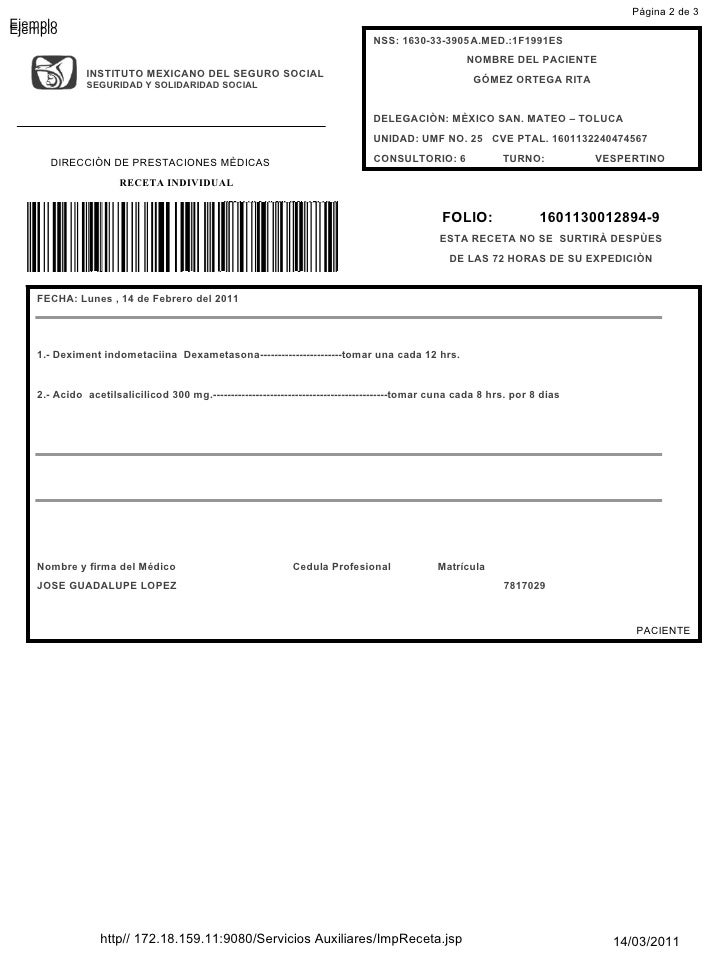
Vida fueron encontrados durante las primeras horas de la ma&241 ana. 24 de diciembre del 2008 (AFN).-. 1 del IMSS por lesiones de arma de fuego. En las primeras horas del d&237 a ejecutan a dos, en hechos distintos.-Un tercero muri&243 en la Cl&237 nica No.

Open Street Map Google Maps. IMSS Cl&237 nica 1 Quintana Roo, Mexico. Existen aspectos de RMFP y AO que provocan mayor insatisfacción en los pacientes crónicos y requieren mayor atención.Home - Mexico - Quintana Roo - IMSS Cl&237 nica 1. En la regresión múltiple, la “autopercepción negativa de la salud” y “tipo de la institución” fueron relacionados con insatisfacción.
A secondary data analysis was conducted. To evaluate the satisfaction and the factors related to dissatisfaction in patients suffering from type 2 diabetes and/or hypertension with care offered in family medicine clinics. I met people from all over not one.Objective. Hgzcmf 1 Imss Chetumal, Quintana RooThis clinic is not fake or out for your money I just left there with much hope for my aunt and uncle both with cancer. Clinica 1 Del Imss Paseo Del Rio, Tijuana, Baja California Coordinate: 32.4773459336, -116.926451439.
There are aspects of the FDPR and OA that reveal dissatisfaction of patients with chronic conditions.Satisfaction of users of health services is a quality-of-care indicator employed to evaluate health care and to identify, from the user perspective, aspects of services that can be improved it also serves as a method to conduct comparative analyses of health care programs. In the logistic regression analysis the covariate “negative self-rated health” and “type of institution” were associated with dissatisfaction. In the FDPR index the items “kindness of the family doctor” (FD) scored high, while the lowest score was for the items: “the FD allows the patient to give an opinion about his/her treatment,” “the patient understands the information” and “the FD spends enough time on the consultation.” As for satisfaction with OA, the items “cleanliness of the clinic” and “ease of administrative procedures” obtained the lowest scores. Approximately half of patients ( n=1 323) were satisfied with care.
The proportion of ambulatory patients receiving care who were satisfied ranged from 64.8% to 88.0%. 5,6In Mexico, a number of studies have evaluated user satisfaction with health care in different public institutions and at different care levels. Specifically, individuals who are satisfied with health care are more likely to comply with treatment regimens and are more willing to continue visiting the same doctor in the same institution. 1-4 Also, satisfaction has an effect on user behavior. Satisfaction is influenced by user characteristics such as gender, age, socio-economic status, and comorbidity, and by the health outcomes achieved by care –principally expectation fulfillment.
As long as their needs and expectations are satisfied, their collaboration in managing illnesses will be maintained and may even increase.The present study has two objectives: to evaluate satisfaction with health care and factors related to dissatisfaction among patients who receive care from the Mexican social security institutes and who suffer from type 2 diabetes and/or hypertension. 10,11Satisfaction with health care on the part of patients with chronic conditions is of particular importance, given that they will interact continuously with health services from the time the disease is detected and diagnosis is confirmed through all stages of their condition. These institutions have reported that hypertension and type 2 diabetes are among the top causes of medical visits to family medicine clinics and of hospitalizations. The two main Mexican social security institutions, which cover 60% of the population, are the Mexican Institute of Social Security (IMSS) and the Institute of Security and Social Services for State Employees (ISSSTE). 7-9Although there is a substantial body of literature addressing patient satisfaction, its focus on chronically ill patients is still incipient in the international arena.In both developed and developing countries the incidence and prevalence of chronic diseases is showing a steady increase and Mexico is facing a growing demand for care of patients with chronic conditions as well.
We included patients older than 20 years of age and who had been receiving care at the clinics over the previous six months.Patients were included when going to a control visit for their chronic disease. The MIAC Study was approved by the Institutional Research and Ethics Review Boards.Cross-sectional data from 1323 ambulatory patients with type 2 diabetes and/or hypertension were collected. The family medicine clinics were selected by convenience.
Unpublished.Each item was scored using a 5-point Likert scale in which the highest satisfaction score was five and the lowest was one. Universidad Autónoma de Aguascalientes 2005. Development and validation of an inventory to measure satisfaction of users of family medicine clinics with hypertension and diabetes in Mexico.
To identify significant factor loadings for the items, load values >0.50 were sought. Each index (factor) was integrated with all items that had a common factor variance >0.30. An exploratory factor analysis was used to identify satisfaction indices by applying a principal components extraction method and orthogonal rotation, reducing the number of items and analyzing relationships among them.
Next, each index was divided into two categories, satisfaction and dissatisfaction. The other index measured satisfaction with the organizational arrangement (OA) and included six items: organization of the clinic, convenience of appointment times, clinic comfort, trust in the quality of clinic care, clinic cleanliness, and resolution of administrative difficulties (Table I).Each item in the FDPR and OA indices was evaluated individually then, the average score of all items in each index was calculated. One index evaluated satisfaction with the family doctor-patient relationship (FDPR) and was composed of eight items: kindness of the family doctor, physical examination, treatment, whether the family doctor allows the patient to give his/her opinion about the treatment, whether the patient understands the information, whether the doctor clarifies patient questions, whether the family doctor spends enough time on the consultation, and general satisfaction with the family doctor. 12 This exploratory factor analysis allowed the creation of two indices.



 0 kommentar(er)
0 kommentar(er)
